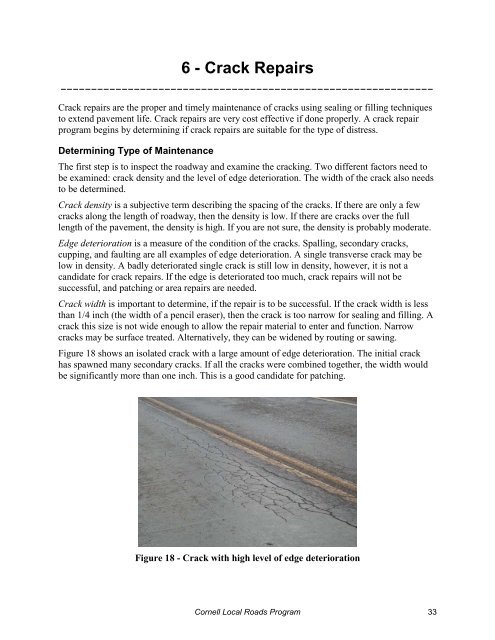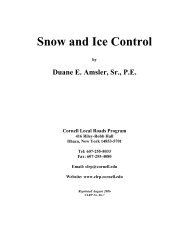Pavement Maintenance - Cornell Local Roads Program - Cornell ...
Pavement Maintenance - Cornell Local Roads Program - Cornell ...
Pavement Maintenance - Cornell Local Roads Program - Cornell ...
You also want an ePaper? Increase the reach of your titles
YUMPU automatically turns print PDFs into web optimized ePapers that Google loves.
6 - Crack Repairs<br />
_____________________________________________________________<br />
Crack repairs are the proper and timely maintenance of cracks using sealing or filling techniques<br />
to extend pavement life. Crack repairs are very cost effective if done properly. A crack repair<br />
program begins by determining if crack repairs are suitable for the type of distress.<br />
Determining Type of <strong>Maintenance</strong><br />
The first step is to inspect the roadway and examine the cracking. Two different factors need to<br />
be examined: crack density and the level of edge deterioration. The width of the crack also needs<br />
to be determined.<br />
Crack density is a subjective term describing the spacing of the cracks. If there are only a few<br />
cracks along the length of roadway, then the density is low. If there are cracks over the full<br />
length of the pavement, the density is high. If you are not sure, the density is probably moderate.<br />
Edge deterioration is a measure of the condition of the cracks. Spalling, secondary cracks,<br />
cupping, and faulting are all examples of edge deterioration. A single transverse crack may be<br />
low in density. A badly deteriorated single crack is still low in density, however, it is not a<br />
candidate for crack repairs. If the edge is deteriorated too much, crack repairs will not be<br />
successful, and patching or area repairs are needed.<br />
Crack width is important to determine, if the repair is to be successful. If the crack width is less<br />
than 1/4 inch (the width of a pencil eraser), then the crack is too narrow for sealing and filling. A<br />
crack this size is not wide enough to allow the repair material to enter and function. Narrow<br />
cracks may be surface treated. Alternatively, they can be widened by routing or sawing.<br />
Figure 18 shows an isolated crack with a large amount of edge deterioration. The initial crack<br />
has spawned many secondary cracks. If all the cracks were combined together, the width would<br />
be significantly more than one inch. This is a good candidate for patching.<br />
Figure 18 - Crack with high level of edge deterioration<br />
<strong>Cornell</strong> <strong>Local</strong> <strong>Roads</strong> <strong>Program</strong> 33





